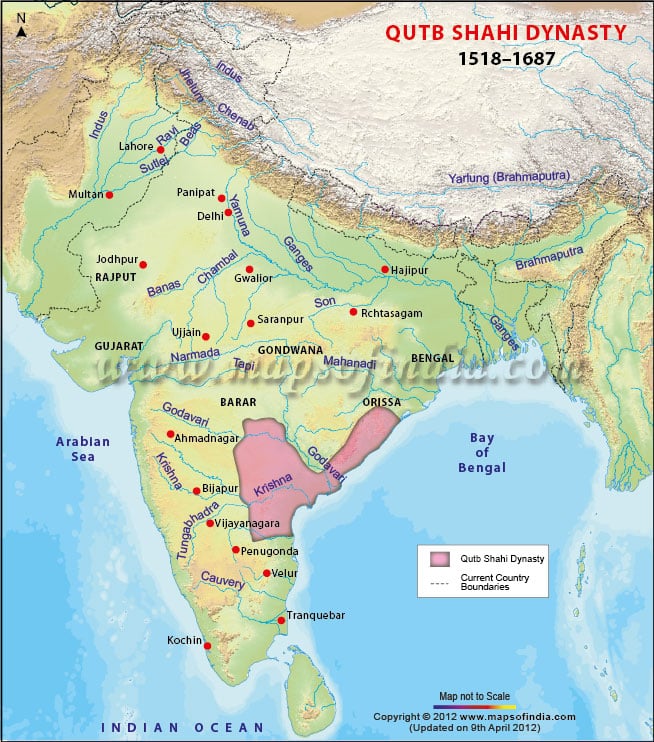- The Qutb Shahi dynasty or the Golkonda Sultanate was known as the ruling family of the sultanate of Golkonda.
- Situated in South India, the Qutb Shahi dynasty was ruled by the Shia Muslims who belonged to the Turkmen tribe from the Turkmenistan-Armenia region.
- This dynasty was founded by Sultan Quli Qutub-ul-Mulk in 1518.
- In 1636, Mughal emperor Shah Jahan forced the Qutb Shahis to recognize Mughal suzerainty and pay periodic tributes.
- The dynasty came to an end in 1687 during the reign of its seventh sultan Abul Hasan Qutb Shah, when the Mughal ruler Aurangzeb arrested and jailed Abul Hasan for the rest of his life in Daulatabad, incorporating Golconda into the Mughal empire.
- The kingdom extended from the parts of modern-day states of Karnataka, Andhra Pradesh, Odisha and Telangana.
- The Golconda sultanate was constantly in conflict with the Adil Shahis and Nizam Shahis.

Qutb Shahi Architecture
Golconda Fort, Qutb Shahi Tombs and Charminar, located in Hyderabad, are the landmarks that together symbolize the Qutb Shahi Dynasty (1518 A.D. to 1687 A.D.).
- The city of Hyderabad served as the capital of the Qutb Shahis, the Asaf Jahi Nizams and is now the capital of the state of Telangana.
- Qutb Shahi Islamic Sultanate was one of the five prominent dynasties that emerged in the Deccan following the downfall of the Bahmani Dynasty in 1518 A.D.
- The monuments of the Qutb Shahi period represent different building typologies.
Golconda Fort
- Golconda is a fortified citadel and an early capital city of the Qutb Shahi dynasty.
- Within its stone fortifications that cover a length of over seven kilometres, the Golconda Fort envelopes a medieval Islamic settlement.
- The historic structures range from military and defensive structures, mortuary baths, silos, mosques, gardens, residential quarters, pavilions and royal courts, showcasing the entire range of structures that catered to life in a medieval fortified town in India.
- The fort at one point housed precious diamonds such as the Hope diamond, Nassak diamond, and the Koh-i-Noor diamond, one of India’s most precious gems.
Qutb Shahi Tombs
- The tombs of Qutb Shahis are a mausoleum complex, a royal necropolis (cemetery) which comprises the tombs of the Royal family and the officials who faithfully served them and also mortuary bath and mosques.
- The complex consists of 30 tombs, mosques and a mortuary bath. The Qutb Shahi tombs collectively constitute an outstanding example of an Indo-Muslim dynastic necropolis and is the most extensive and best epigraphically documented in all of India.
- The tombs are graceful structures with intricately carved stonework. The tombs display a distinctive style, a mixture of Persian, Pathan and Hindu forms.
- The material used for constructing these tombs was grey granite embellished with stucco (durable finish for exterior walls) ornamentation.
- The tombs form a large cluster and stand on a raised platform. They are domed structures built on square bases surrounded by pointed arches.
- Each tomb stands on a wide quadrangular terrace approached on all sides by flights of steps. The galleries of the smaller tombs are single storied while the larger ones are two storied.
Charminar
- Charminar is a ceremonial Gateway built to celebrate the foundation of Hyderabad, a new Millennial City, in 1591 A.D.
- Its date of construction that marks the beginning of the second Islamic millennium, an event that was widely celebrated in the Islamic world and therefore suggestive of Hyderabad being deliberately founded as a “Millennial” city.
- It was the first monument in the world constructed using lime mortar and granite, it was only after its construction that the architects throughout the world recognised the strength of lime-mortar in raising huge structures.
- It stands at the crossing of two arterial axes in the old city of Hyderabad and forms the symbolic fulcrum of the city, with its four gateways oriented towards the cardinal directions.
- Charminar provided a point of origin and reference point for the planning grid that determined the layout of the city of Hyderabad.
